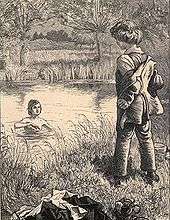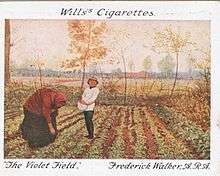Frederick Walker (painter)

Frederick Walker ARA RWS (London 26 May 1840 – 4 June 1875 St Fillans)[1] was an English social realist painter and illustrator described by Sir John Everett Millais as "the greatest artist of the century".
Life and work

Early Life and training
Walker was born at 90 Great Titchfield Street, Marylebone in London, the elder of twins and the 5th son of William Henry, Jeweller, and Ann (née Powell) Walker - he was one of 8 children. His grandfather, William Walker had been an artist of some merit, who had exhibited regularly at the Royal Academy and British Institution between 1782–1802. Fredrick's mother was an embroideress, and became the family's chief breadwinner when his father died in 1847.
Frederick received his education at a local school and later at the North London Collegiate School in Camden. He showed a talent for art from an early age teaching himself to copy prints using pen and ink - he also practiced drawing in the British Museum. From 1855–57 he worked in an architect's office in Gower Street but gave up architecture to become a student at the British Museum and at James Mathews Leigh's art school.
In March 1858 he was admitted as a student at the Royal Academy, and later that year also became a part-time apprentice wood engraver to Josiah Wood Whymper in Lambeth. It was here that he met fellow artists J W North and George Pinwell. During the 2 years of his apprenticeship he continued to paint in his spare time, in both oils and watercolours.
The Illustrator

In 1859 he joined the Artists' society in Langham Chambers, and from 1860–65 achieved great success as a black and white illustrator for popular journals of the day such as Cornhill Magazine, Once a Week, Good Words, Everybody's Journal, and Leisure Hour.[2] Much of his work during this period was engraved by Joseph Swain. He was introduced to satirist and author William Thackeray, the Cornhill's editor, for whom he provided drawings (e.g. "Comfort in grief") for "The Adventures of Philip", initially published as a serial but then as a book in 1862. He also illustrated Thackeray's unfinished novel "Denis Duval", magazine stories by Thackeray's daughter Ann Ritchie (many of these drawings later reproduced in watercolour), and provided drawings (e.g. "Summer days") for the Dalziel brothers which appeared in 2 poetry books, "A Round of Days"[3] and "Wayside Posies".[4]
The artist
Walker produced his first important watercolour, Strange faces[5] in 1862 (Yale Center for British Art, New Haven), and in the following year Philip in Church[6] which won a medal at the Paris Exhibition of 1867. Walker exhibited at the Old Watercolour Society from 1864 until the end of his life, becoming an associate member in February 1864.[7] He was later made a full member in 1866, which entitled him to add the postnominal initials 'RWS' after his name. He was also elected an honorary member of the Belgian Watercolour Society in 1871.
In 1863 Walker exhibited his first oil painting, The Lost Path at the Royal Academy of Arts, and thereafter showed Wayfarers (1866; Private collection), Bathers (1867; Lady Lever Art Gallery), Vagrants (1868; Tate, London), The Old Gate[8] (1869), The Plough (1870; Tate, London), At the Bar (1871; Untraced), The Harbour of Refuge[9] (1872) and The Right of Way (1875). In 1871 he was elected an Associate Royal Academician (ARA).
Final years
Walker never married and lived all his life in London with members of his family - brother John (d. 1868), sister Fanny (d. 1876) and mother (d. 1874) - residing in Bayswater from 1863. He twice visited Paris (in 1863 and 1867) and Venice (1868 and 1870 - in the latter year with his friend William Quiller Orchardson). In 1873 he travelled to Algiers in an unsuccessful attempt to recuperate from a bout of tuberculosis, which gradually worsened until his death in June 1875 at St Fillans in Perthshire, Scotland. He was buried at Cookham.

Books partly illustrated by Walker
- Thackeray, W. M. The Adventures of Philip[10] (London: Smith, Elder & Co, 1862).
- Dalziel, George. A Round of days[3] (London: Routledge, 1866).
- Buchanan, R. W. Wayside Posies[4] (London: Routledge, 1867).
- Thackeray, W. M. Denis Duval[11] (London: Smith, Elder & Co, 1867).
Notes

- ↑ Armstrong 1899, pp. 51–53
- ↑ Walker's first published illustration was in Everybody's Journal, 14 January 1860, for a story by Edmond About called "The Round of Wrong" (Phillips, p. 11).
- 1 2 "A Round of days described in original poems". Internet Archive.
- 1 2 "Wayside posies; original poems of the country life". Internet Archive.
- ↑ "Strange Faces - Frederick Walker - The Athenaeum". the-athenaeum.org.
- ↑ "'Philip in Church', Frederick Walker - Tate". Tate.
- ↑ 'Minor topics of the month', The Art Journal, March 1864, p. 90.
- ↑ "'The Old Gate', Frederick Walker - Tate". Tate.
- ↑ "'The Harbour of Refuge', Frederick Walker - Tate". Tate.
- ↑ "The adventures of Philip on his way through the world : shewing who robbed him, who helped him, and who passed him by : to which is now prefixed A shabby genteel story". Internet Archive.
- ↑ "Denis Duval, Lovel the widower, The Wolves and the lamb, The second funeral of Napoleon ... with illustrations by the author and by Frederick Walker". Internet Archive.
Further reading
%2C_Our_Village_(Cookham)%2C_1873.jpg)
- Carr, J. Comyns. Essays on Art[1] (London: Smith, Elder, & Co, 1879), pp. 198–222.
- Marks, John George. Life and letters of Frederick Walker, A. R. A.[2] ( London: Macmillan & Co, 1896).
- Phillips, Claude, Sir. Frederick Walker and his works[3] (London: Seeley & Co, 1897).
- Black, Clementina. Frederick Walker[4] (London: Duckworth & Co, 1902).
- Redgrave, Gilbert Richard. A history of water-colour painting in England[5] (London: Society for Promoting Christian Knowledge, 1905) pp. .
References
![]() This article incorporates text from a publication now in the public domain: Chisholm, Hugh, ed. (1911). "Walker, Frederick". Encyclopædia Britannica. 28 (11th ed.). Cambridge University Press.
This article incorporates text from a publication now in the public domain: Chisholm, Hugh, ed. (1911). "Walker, Frederick". Encyclopædia Britannica. 28 (11th ed.). Cambridge University Press.
 Armstrong, Walter (1899). "Walker, Frederick". In Lee, Sidney. Dictionary of National Biography. 59. London: Smith, Elder & Co. pp. 51–53.
Armstrong, Walter (1899). "Walker, Frederick". In Lee, Sidney. Dictionary of National Biography. 59. London: Smith, Elder & Co. pp. 51–53.
External links
| Wikimedia Commons has media related to Frederick Walker. |
- Works by or about Frederick Walker at Internet Archive
- Fred Walker ARA (Biog at southwilts.com)
- Frederic Walker (Art Renewal Center Museum)
- Frederic Walker (Victorian web)
- Frederic Walker online (artcyclopedia.com)
- Walker at the Tate Gallery
- Autumn (1865 painting at the V & A)
- Spring (1865 painting at the V & A)
- Profile on Royal Academy of Arts Collections
- ↑ "Essays on art". Internet Archive.
- ↑ "Life and letters of Frederick Walker, A. R. A.". Internet Archive.
- ↑ "Frederick Walker and his works". Internet Archive.
- ↑ "Frederick Walker". Internet Archive.
- ↑ "A history of water-colour painting in England". Internet Archive.